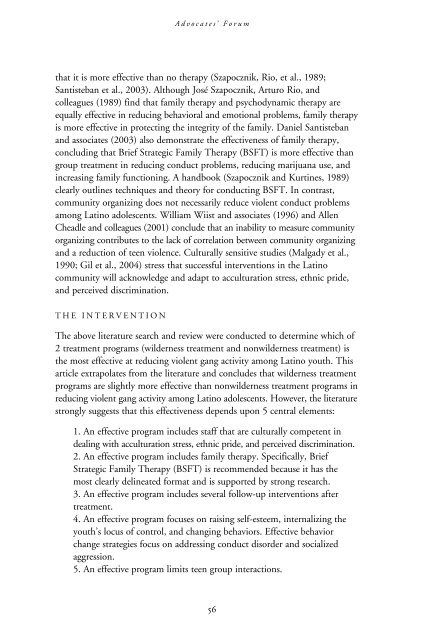2006 - School of Social Service Administration - University of Chicago
2006 - School of Social Service Administration - University of Chicago
2006 - School of Social Service Administration - University of Chicago
You also want an ePaper? Increase the reach of your titles
YUMPU automatically turns print PDFs into web optimized ePapers that Google loves.
Advocates’ Forum<br />
that it is more effective than no therapy (Szapocznik, Rio, et al., 1989;<br />
Santisteban et al., 2003). Although José Szapocznik, Arturo Rio, and<br />
colleagues (1989) find that family therapy and psychodynamic therapy are<br />
equally effective in reducing behavioral and emotional problems, family therapy<br />
is more effective in protecting the integrity <strong>of</strong> the family. Daniel Santisteban<br />
and associates (2003) also demonstrate the effectiveness <strong>of</strong> family therapy,<br />
concluding that Brief Strategic Family Therapy (BSFT) is more effective than<br />
group treatment in reducing conduct problems, reducing marijuana use, and<br />
increasing family functioning. A handbook (Szapocznik and Kurtines, 1989)<br />
clearly outlines techniques and theory for conducting BSFT. In contrast,<br />
community organizing does not necessarily reduce violent conduct problems<br />
among Latino adolescents. William Wiist and associates (1996) and Allen<br />
Cheadle and colleagues (2001) conclude that an inability to measure community<br />
organizing contributes to the lack <strong>of</strong> correlation between community organizing<br />
and a reduction <strong>of</strong> teen violence. Culturally sensitive studies (Malgady et al.,<br />
1990; Gil et al., 2004) stress that successful interventions in the Latino<br />
community will acknowledge and adapt to acculturation stress, ethnic pride,<br />
and perceived discrimination.<br />
THE INTERVENTION<br />
The above literature search and review were conducted to determine which <strong>of</strong><br />
2 treatment programs (wilderness treatment and nonwilderness treatment) is<br />
the most effective at reducing violent gang activity among Latino youth. This<br />
article extrapolates from the literature and concludes that wilderness treatment<br />
programs are slightly more effective than nonwilderness treatment programs in<br />
reducing violent gang activity among Latino adolescents. However, the literature<br />
strongly suggests that this effectiveness depends upon 5 central elements:<br />
1. An effective program includes staff that are culturally competent in<br />
dealing with acculturation stress, ethnic pride, and perceived discrimination.<br />
2. An effective program includes family therapy. Specifically, Brief<br />
Strategic Family Therapy (BSFT) is recommended because it has the<br />
most clearly delineated format and is supported by strong research.<br />
3. An effective program includes several follow-up interventions after<br />
treatment.<br />
4. An effective program focuses on raising self-esteem, internalizing the<br />
youth’s locus <strong>of</strong> control, and changing behaviors. Effective behavior<br />
change strategies focus on addressing conduct disorder and socialized<br />
aggression.<br />
5. An effective program limits teen group interactions.<br />
56
















